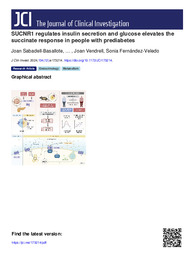Please use this identifier to cite or link to this item:
https://hdl.handle.net/11000/38552Full metadata record
| DC Field | Value | Language |
|---|---|---|
| dc.contributor.author | Sabadell-Basallote, Joan | - |
| dc.contributor.author | Astiarraga, Brenno | - |
| dc.contributor.author | Castaño, Carlos | - |
| dc.contributor.author | Ejarque, Miriam | - |
| dc.contributor.author | Repollés de Dalmau, Maria | - |
| dc.contributor.author | Quesada, Ivan | - |
| dc.contributor.author | Blanco, Jordi | - |
| dc.contributor.author | Núñez-Roa, Catalina | - |
| dc.contributor.author | Rodríguez-Peña, M. | - |
| dc.contributor.author | Martínez, Laia | - |
| dc.contributor.author | F De Jesus, Dario | - |
| dc.contributor.author | Marroqui Esclapez, Laura | - |
| dc.contributor.author | Bosch, Ramon | - |
| dc.contributor.author | Montanya, Eduard | - |
| dc.contributor.author | Sureda, Francesc | - |
| dc.contributor.author | Tura, Andrea | - |
| dc.contributor.author | Mari, Andrea | - |
| dc.contributor.author | Kulkarni, Rohit N. | - |
| dc.contributor.author | Vendrell, Joan | - |
| dc.contributor.author | Fernández-Veledo, Sonia | - |
| dc.contributor.other | Departamentos de la UMH::Fisiología | es_ES |
| dc.date.accessioned | 2025-11-27T13:21:33Z | - |
| dc.date.available | 2025-11-27T13:21:33Z | - |
| dc.date.created | 2024 | - |
| dc.identifier.citation | The Journal of Clinical Investigation | es_ES |
| dc.identifier.issn | 1558-8238 | - |
| dc.identifier.issn | 0021-9738 | - |
| dc.identifier.uri | https://hdl.handle.net/11000/38552 | - |
| dc.description.abstract | Pancreatic β cell dysfunction is a key feature of type 2 diabetes, and novel regulators of insulin secretion are desirable. Here, we report that succinate receptor 1 (SUCNR1) is expressed in β cells and is upregulated in hyperglycemic states in mice and humans. We found that succinate acted as a hormone-like metabolite and stimulated insulin secretion via a SUCNR1-Gq-PKC–dependent mechanism in human β cells. Mice with β cell–specific Sucnr1 deficiency exhibited impaired glucose tolerance and insulin secretion on a high-fat diet, indicating that SUCNR1 is essential for preserving insulin secretion in diet-induced insulin resistance. Patients with impaired glucose tolerance showed an enhanced nutrition-related succinate response, which correlates with the potentiation of insulin secretion during intravenous glucose administration. These data demonstrate that the succinate/SUCNR1 axis is activated by high glucose and identify a GPCR-mediated amplifying pathway for insulin secretion relevant to the hyperinsulinemia of prediabetic states. | es_ES |
| dc.format | application/pdf | es_ES |
| dc.format.extent | 16 | es_ES |
| dc.language.iso | eng | es_ES |
| dc.publisher | American Society for Clinical Investigation | es_ES |
| dc.relation.ispartofseries | 134 | es_ES |
| dc.relation.ispartofseries | 12 | es_ES |
| dc.rights | info:eu-repo/semantics/openAccess | es_ES |
| dc.rights | Attribution-NonCommercial-NoDerivatives 4.0 Internacional | * |
| dc.rights.uri | http://creativecommons.org/licenses/by-nc-nd/4.0/ | * |
| dc.subject.other | CDU::6 - Ciencias aplicadas::61 - Medicina::612 - Fisiología | es_ES |
| dc.title | SUCNR1 regulates insulin secretion and glucose elevates the succinate response in people with prediabetes | es_ES |
| dc.type | info:eu-repo/semantics/article | es_ES |
| dc.relation.publisherversion | https://doi.org/10.1172/JCI173214 | es_ES |

View/Open:
6_2024_SUCNR1 regulates insulin secretion and glucose elevates the succinate response in people with prediabetes.pdf
7,3 MB
Adobe PDF
Share:
.png)
